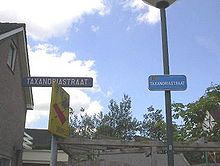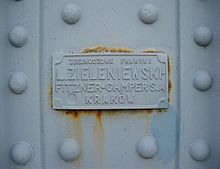- Nameplate
-
For a newspaper's logo, see Nameplate (publishing).
A nameplate identifies and displays a person or product's name. Name plates are usually shaped as rectangles but are also seen in other shapes, sometimes taking on the shape of someone’s name. The primary use of name plates is for informative (as in an office environment, where name plates are mounted on doors or walls in order to identify employees) and commercial purposes (as in a retail environment, where name plates are mounted on products to identify the brand). Whereas name tags tend to be worn on uniforms or clothing, name plates tend to be mounted onto an object (e.g. cars, amplification devices) or physical space (e.g. doors, walls, or desktops). Nameplates are also distinct from name plaques. Plaques are items of larger dimensions that are designed to communicate more information than a name and title.
Contents
Office nameplates
Office nameplates generally are made out of plastic or wood and usually contain one or two lines of text. The standard format for an office nameplate is to display a person’s name on the first line and a person’s job title on the second line. It is common for organizations to request nameplates that exclude the job title. The primary reasons for excluding job titles are to extend the longevity of a name plate and to promote a culture of meritocracy, where the strength of one’s thoughts are not connected to one’s job title. Name plates without job titles have longer lives because someone can reuse the same name plate after changing job titles. It is rare for an office name plate to contain three or more lines of text. Although office name plates range in size, the most popular name plate size is 2 inches x 8 inches (5.08 cm x 20.32 cm). Office name plates typically are made out of plastic. This is because plastic is an inexpensive material relative to wood and metal. More expensive name plates can be manufactured out of bronze. To promote consistency, organizations tend to use the same style name plate for all employees. This helps to achieve a standard look. Office name plates are not restricted to for-profit enterprises. Many non-profit and governmental agencies have a need for name plates. For plastic and wooden name plates, the names are etched into the material through a number of processes, including mechanical engraving, laser engraving, or whittling.
Personal name plates
Name plates are also popular for personal reasons. Parents often like to adorn the doors of their children’s rooms with name plates. These name plates are conventionally crafted out of wood, not plastic or metal. Because the name plates are meant for children, these personal name plates tend to come in fun shapes. Examples of fun shapes include teddy bears, bluebirds, dogs, and the child’s name. These name plates also tend to be more colorful than office name plates. Mounting options are either by nail or by adhesive. Wooden name plates are not normally glued onto doors, as the glue may leave a messy residue and make it harder to remove the name plate. Larger personal name plates also include graphics or artwork, such as a horse or a baseball bat, that match the interests of the identified person. The graphics or artwork reinforce the individuality and personalization established by the name plate.
There is a growing trend to use name plates for vanity purposes. In these cases, the name plates are fashioned out of gold, silver, or other metals and worn as a form of jewellery. These name plates are similar to vanity plates found on automobiles. They are available in a multitude of styles and colors, ranging from bronze to pink. Most commonly, these vanity name plates are worn as necklaces or bracelets.
Name plate holders
Name plates are usually sold as two separate components: the manufactured name plate insert and the name plate holder. This setup allows the name plate insert to be used in a variety of settings depending on the specific holder—the same plastic, wood, or metal name plate insert can usually be removed and reinserted into another holder style with minimal effort; thereby creating a new name plate application. Various name plate holders range from wall and door mounts, desk holders, to cubicle hangers.
Name plates on products
Name plates are used on many products to designate the producer, the brand, and/or the product name, as well as properties of the product such as power and mass. Additionally, they may be placed on a product for decorative value, for placement of product information (e.g. serial code), or for approval/recognition (e.g. an endorsement by a governing body). When strategically placed on a product, nameplates often extend the impact of a logo or brand and heighten the connection to the value of the product. Many nameplates must meet certain requirements for print life, and environmental tolerances base on location or environment the product might be used in.
Nameplate differ from labels in that they are usually designed for long term product marking. They are usually under printed on some sort of transparent material with a industrial grade adhesive or mechanical attachment.
Modern manufacturing processes allow for diverse styles of nameplate design. Nameplates can be two- or three-dimensional; made of various metals (aluminum, zinc), stainless steel or brass, man-made materials (e.g. Mylar or Vinyls) or injection-molded plastic; and thickness, color, and size can all be customized. Additional design features and production techniques common to nameplate manufacturing include etching, branding, and engraving.[1]
Nameplates can be mounted or bound to the object that they are labeling by rivets, screws, or adhesive.
Graphic Overlay Nameplates
Graphic Overlay Nameplates are constructed from hard-coated polycarbonate, hard-coated polyester or UV resistant polyester. Graphic Overlay Nameplates differ from generic Nameplates in that they feature transparent windows, selective texturing, embossing, abrasion protection and chemical resistance. A Graphic Overlay is usually over some sort of LEDs, Windows, switch, or control panel.
A graphic overlay is a screen or digitally printed product incorporating processes such as embossing, selective texturing and transparent display windows. Not only does a graphic overlay provide aesthetic appeal to a device, but it can also provide environmental protection. A graphic overlay can be used in an assembly using discrete switches or laminated to a membrane switch.
Name plates used in industry
Industrial strength name plates are required to withstand harsher operating environments compared to those used in the home and office. All industries that require long term product identification or marking used nameplates for branding, identification, instructions, and other marketings. Industrial name plate manufacturers can offer a variety of different nameplates for a wide range of applications. The properties of the name plates that vary from application to application include: Material (including aluminum, stainless steel or titanium), thickness, Custom Graphics, Screen printing, Etching, and Anodizing, Adhesive backing, UL and CSA approval, Serialization, Military Standards and Embossing. Japanese term for nameplate (銘板 meiban) in industrial use is meiban.
Rail transport usage
In rail transport, a nameplate is a plate attached to a locomotive or other item of rolling stock that carries a name. Nameplates are often collected as memorabilia.
Welsh Highland Railway locomotive "Russell" is unusual in having carried two different designs of nameplate during its operational life.[2]References
External links
Categories:- Infographics
- Signage
Wikimedia Foundation. 2010.



